
“Welcome, my sister!”
This was Duke Durant, manager of the Black Wall Street Gallery. The space was
sunlit and open. I spun slowly around the room, turning my head to take in every wall, corner, and table.
The Greenwood section of Tulsa was known as Black Wall Street in the early 20th century because of the number of affluent Black families and Black-owned businesses there. On May 30, 1921, a 19-year-old Black man named Dick Rowland, who worked as a shoe-shine, went into the Drexel building in downtown Tulsa—he needed a bathroom, and the one in the Drexel building was the only one Blacks could use in the neighborhood. The elevator was operated by white girl, Sarah Page, 17.
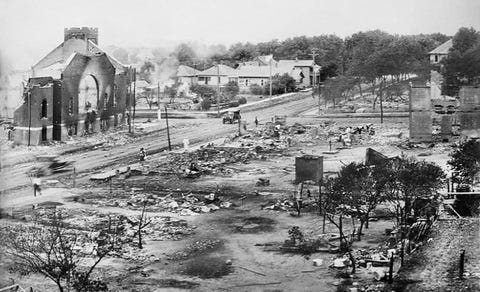
No one knows exactly what happened next. Some reports say Rowland tripped and fell into Page. Others claimed he attempted to rape her. The encounter set off one of the deadliest race riots in American history, the Tulsa Race Massacre, primarily in the Greenwood section, where I now stood in an art gallery.
There was the wall straight ahead: The James Baldwin quotation “Artists are here to disturb the peace” served as the header for that collection of sculpted ceramic full-face masks bulging out the wall. All different shades. Some with sharp cheekbones. Some wore fedoras and berets, and one had a big ole fro bun.
Girl, you made it
You made it.
Aw yeah, you made it, you made it.
Baby girl, you made it, you made it.
Aw yeah, you made it.
You made it.
I vibe to this. Hit Shazam. I had never heard that Teyana Taylor song before.
Self-love is the best love.
You made it.
Yeah. Yeah.
It was a whole mood in there. Duke told me he wanted this to be the living room of Black Wall Street, where you walk in after you’ve had some soul food at Wanda J’s, a few steps away from the gallery.
The drive up from Dodge City, Kansas, had taken closer to six hours than the five Google estimated because I took my sweet time and stopped at more gas stations. The night before was the least amount of sleep I had gotten, just under three hours. My mind raced about the next day and the day after next and on and on. When I got to Tulsa, I sat in my rented red MINI Countryman for a while, listening to Britt Nicole, looking at my calendar and my itinerary. What am I even doing? Trying to learn this country, I guessed. Turns out it’s a big country. It still felt like I was still at the bottom of that mountain looking up, even though I had just made it to my twenty-fourth city, twenty-second state.

I walked. I stopped at every corner. I saw the Drexel building. I heard live opera emanating from a baseball field. I look for an open entrance, but couldn’t find one. In the distance, I saw a woman, alone, standing at home plate, singing.
Down Archer Street was where I saw the stained-glass windows on the gallery: Basquiat. Angela Davis. Spike Lee. Nina Simone. Malcolm X. Toni Morrison.
Yes, please.
Duke told me a story: Over the summer, a white woman tippy-toed into the store. From the entrance, she said, “I support Black businesses.” Asked to buy a t-shirt. Duke wasn’t having that. “Ma’am, are you slaveowner?” He asked her. A smirk on his face. “Oh my god, no!” She laughed, all nervous. “Then come in,” he said. “I’m sure you’re tired.” And then he said, real calm: “Let’s talk about 400 years of slavery. Let’s talk about the massacre. Let’s play some Ray Charles. Some Stevie. Let’s have a real talk about why you benefit from a two-pillar system and what that looks like in a white home versus a Black home. Let’s get in on the school-to-prison pipeline. North Tulsa just broke ground on its only grocery store, and yet it has no hospitals. It's also predominately Black. So subsequently, North Tulsans live twelve years less than South Tulsans. You got a heart attack? You have to wait for them to come get you from South Tulsa. You may very well die while you wait. So, ma’am, let’s talk about that.”
I was getting the picture of Duke Durant.
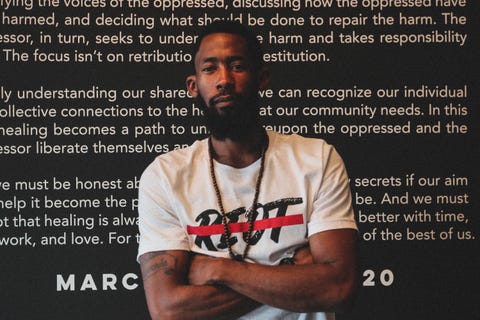
He directed my attention to Greenwood Street. “Right out there,” he said, “Black Lives Matter was painted there in yellow letters just two days ago.” For years the city had been promising repairs and to repave that street. The second the BLM painting went down, city workers washed off the BLM painting and repaved, and the city approved a solidarity rally for the Blue Lives Matter group for that weekend. Down that same street.
“So, what does that tell you?”
(Duke wasn’t kidding: This was some woke living room.)
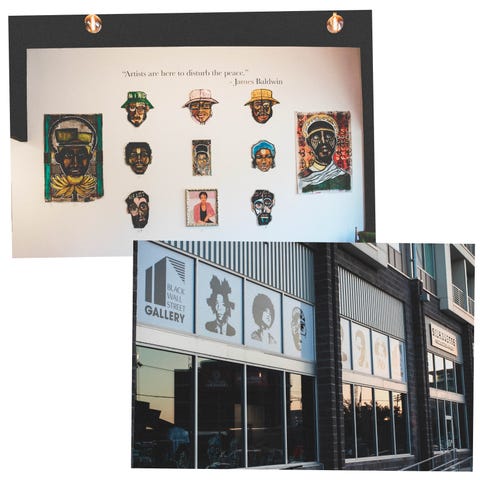
As he spoke, I looked at eight portraits laid out on the floor: Trayvon Martin, Aiyana Jones, Eric Garner, Michael Brown, Christian Taylor, Tamir Rice, Terence Crutcher, and Walter Scott. The Sandra Bland and George Floyd portraits were recently sold, Duke told me.
They were done by a local artist named Terricia Foster. She had etched each face in white on a black background with a hip, slanted handwriting-style at every corner about who they were, how they died, how old they were. For Trayvon, the word “Skittles” was in Skittles colors. On Tamir Rice’s portrait, in large red letters, the word FAKE was next to PISTOL. I was inches away from every one of those pieces, admiring every line and message. Duke saw it in my face and called the artist, who lived a few doors down.
And here she was!
She had a dark brown wide-brim hat, tan blazer, some jean shorts, and personality for days. She had just finished working out before coming over and was all legs.
Foster told me she started working on the collection four years ago, with Trayvon Martin and Tamir Rice as some of the core pieces, for her senior project while studying graphic design and art history at the University of Tulsa.
“It’s so unfortunate that it can apply to now,” she said.
In June, Terrecia got laid off from her commercial real-estate job when the company downsized because of the effects of Covid. She’s been on unemployment since. It was a blessing, though, was how she looked at it. She always felt like the Black token there, anyway. And she was able to return to her art. She also took to journaling daily and getting closer to God. Recently, she got a word from her quiet meditation moments: perseverance. “I feel empowered because I get to do things like my art. I’m still using my voice. And I think through all these things, that Black women, though it's been trying for us—you know, we have so many daggers coming at us—we still continue to push on.”
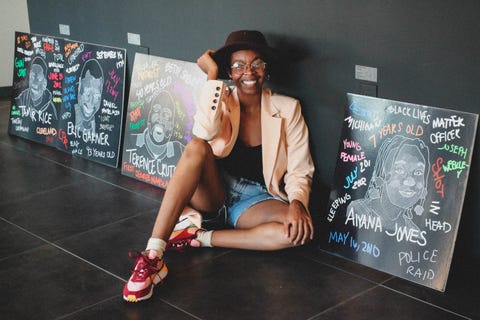
Before the layoff, she started to see more and more that her team just didn’t understand Black people. They had these weekly “fun” meetings called Friday Questions, where coworkers would do extended icebreakers and bonding activities. One day, when the question was “Who is your favorite comedian?” not one person knew who Issa Rae was, the creator and star of HBO’s Insecure. After everyone had started working from home, and George Floyd happened, at first no one even mentioned it. Not in a meeting. Not in a note. It took the company two full weeks to mention it in an email. No one checked up on her. The overall vibe was, “Let’s just brush this under the rug and carry on with our business.”
She felt the power to change in her art. Not only was it helping her get through the longest year ever, but it was her way to educate people in a way other media can’t. To make people less afraid to look under the rug. When she was in college, just four years ago, most people she knew didn’t know about the Black Lives Matter movement.
Holding a Newport cigarette box, Duke walked to the center of the gallery, to where I’m standing, and said, “I think I’m going to put this up as an exhibit in the middle of the gallery.
A few people chuckled. I just looked at him and said, “I’m confused.”
“It speaks volumes,” he said. Loud. Triumphant, even.
Duke was something else. He was a comedian. Not like “He’s so funny, he could be a comedian.” It’s his actual side hustle. (Or was the gallery his side hustle?) He had an irresistible charisma and presence about him. Basketball-player lean. Smooth, chocolatey skin. All “my sister” to this person, “my brother” to the next.
“To what?” I ask. Still not getting this Newport thing.
“So, we’re targeted.” Duke said. About to break it down:
“In Jet magazine, for years, and I think Ebony,” he always remembered seeing the Newport ads.
“They don’t even sell Newport overseas,” his friend, Amman Raheem, chimed in. “When I was deployed, man, you couldn’t find ‘em.”
“You couldn’t!” Duke agreed. “I once sold a guy Newports in—” he turned to Amman. “Where were we at? Jordan?”
Amman nodded.
“For fifty dollars!” Newports targeted Blacks, Duke said. The manufacturers saw them as uneducated and poor, an ideal population to market menthol cigarettes to. (I had never heard this. The internet educated me that night, when I dove into study after study.)
The manufacturers saw them as uneducated and poor, an ideal population on which to study the long-term effects of menthol. (I had never heard this. The internet educated me that night, when I dove into study after study.)
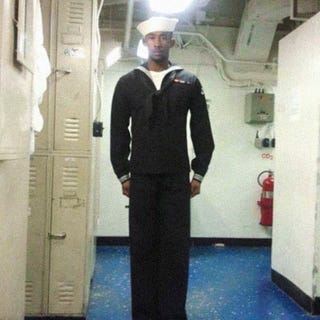
What happened was, there was this guy on the base, almost done with his service. One night he texted Duke asking if he knew where he could get some weed. Duke said no. A few days later, he told me, the guy got busted for having an unregistered gun on the base. The NCIS searched his phone, found the texts to Duke—and Duke was charged with not reporting the man and with using drugs. Duke told me he was then drug-tested five times and passed them all.
Then he was stripped of his military bearing.
He noted that all the white guys involved in the investigation were not excused from duty. None lost their military bearing, he said.
Some jazz tune blasted now. I could make out a sax, the piano, a trumpet? It was calming. I could pass right out to this. We carried our conversation from the back of the gallery to the entrance, talking in louder voices the more the song dropped and increased in volume. There was so much to be done before Blacks can be seen in America, Duke was saying. That was happening more now, though, especially with Covid. “A lot of brothers are being forced to sit down, maybe take a break from finally making it to that executive job, and be at home with their families, were forced to watch this propaganda”—the news coverage of the killings of Black Americans—“and make a decision about it.” The attacks that were intended to break the will of Blacks were in fact giving them strength. It’s only promoting cohesiveness amongst the brothers.
“We haven’t been seen, but we will be seen.”
When I walked back to the hotel, it was dark. My cellphone was on 2%. The streetlights guided me.
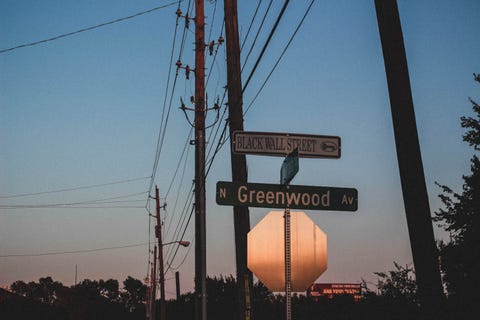
“Just keep heading down that way,” I said. “You can’t miss it.”
I hoped, truly hoped, they would stop in to the Black Walk Street Gallery. Maybe ask to buy a t-shirt. And that they would hear Duke’s story.

